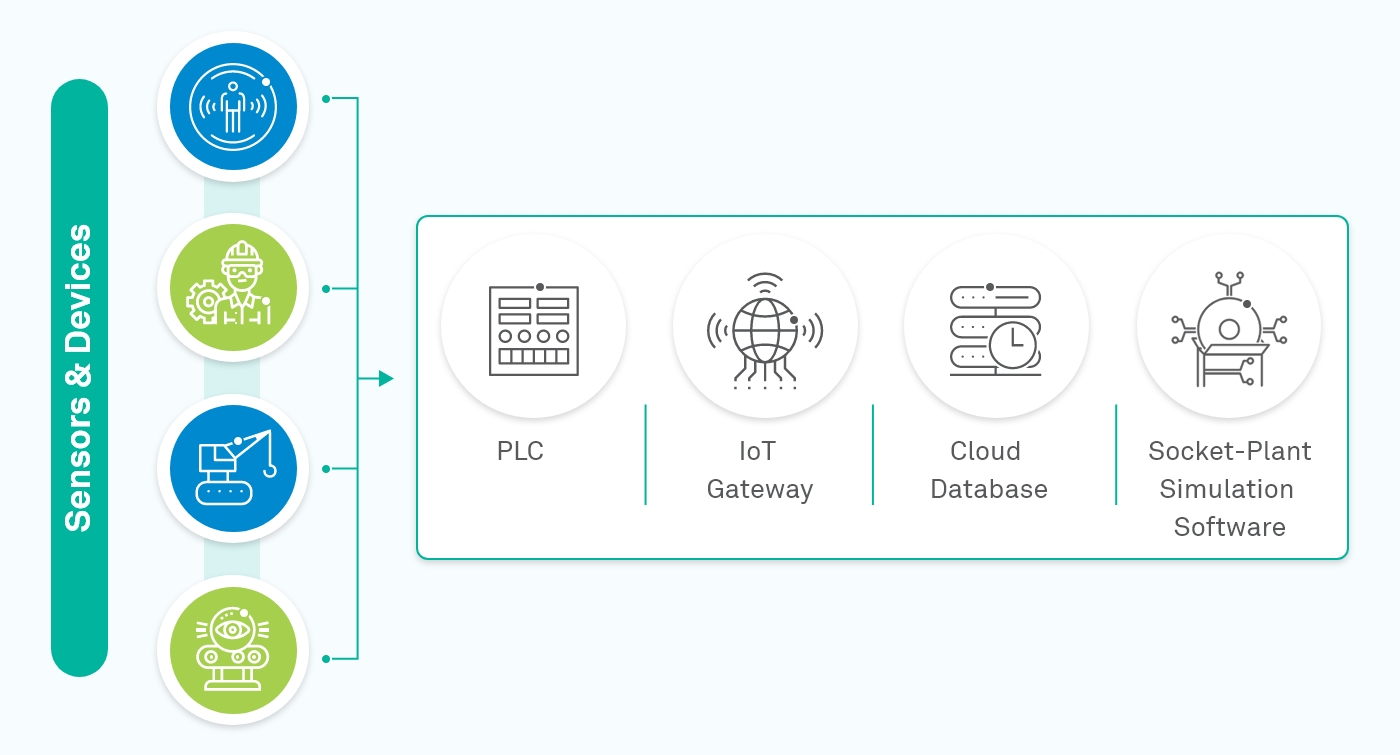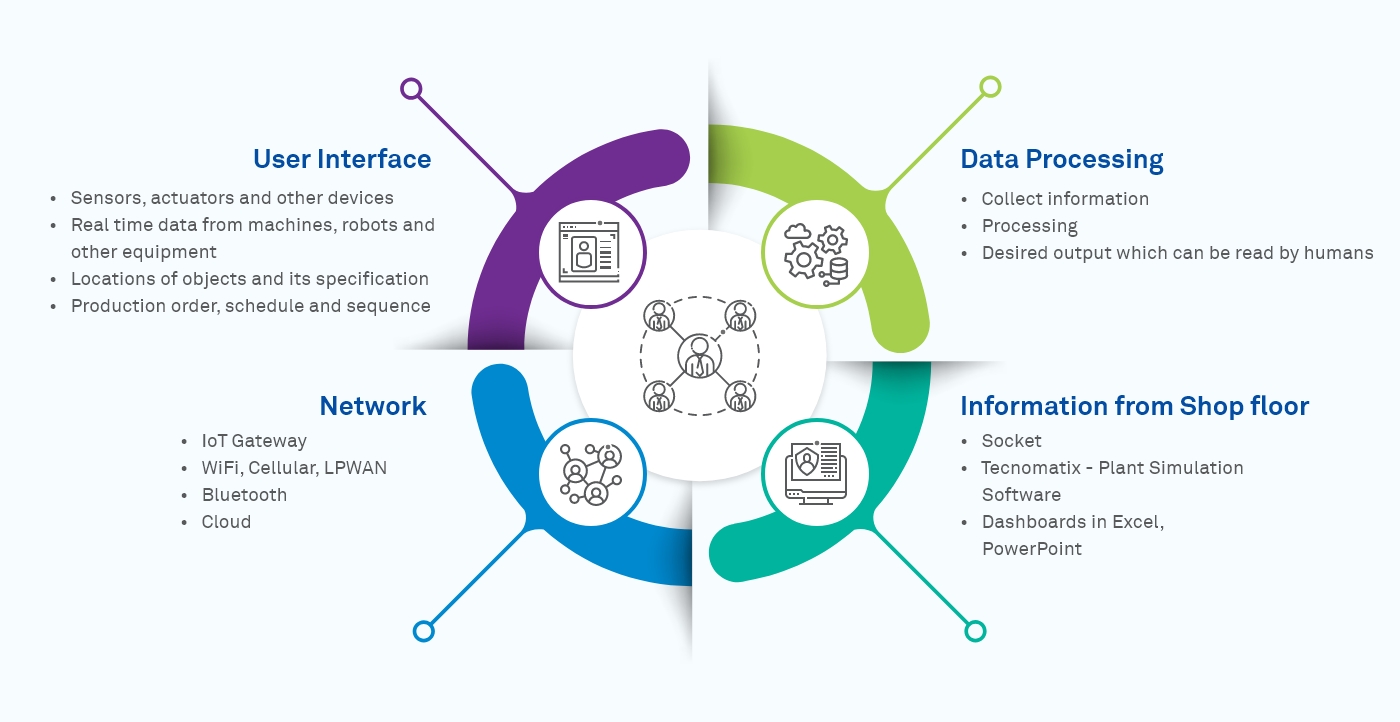Manufacturing plants are complex in nature. Changes in a product or introduction of new products to market are frequent. Also, order, process flow, inventory, logistics and resources keep changing. Plant Managers within different departments end up spending a lot of effort and time to implement these changes, which affects the production process, throughput, cost, and time.
How can IoT help?
IoT can be embedded in a large number of applications in manufacturing plants. It helps in understanding and simplifying the process flow, tracking the products, managing the work in process, balancing the line, and optimizing the material flow movement in the warehouse as well as the inventory level. It can collect enormous amount of data in real time based on the number of sensors and devices attached.
What can Digital Twin do?
Digital Twin tool replicates the real-world system in the virtual machine to predict the effect of changes on existing systems and can also analyze the quality and performance of new systems. Through a virtual model, it can help identify defects, and predict the end of life of a product. Digital Twins can make production efficient, reduce time to market for new products, and help bring down maintenance costs.
What happens when IoT and Digital Twin come together?
The collected data from IoT can be integrated with the Digital Twin tool to analyze the effectiveness, efficiency and accuracy of the system without affecting the real-world system. Digital Twin can collect the information from IoT sensors, and conduct a series of repeated trial-and-error experiments for the purpose of either understanding the behavior of the system and/or evaluating various strategies for operation of the system.

Figure 1: Information flow from applications to software through IoT and vice versa
Figure 1 shows an architecture of integration of IoT with Tecnomatix Plant simulation software, which permits the exchange of data and information between the physical systems and the virtual machine. Simulation models are updated with the data gathered, based on the frequency, and exhibit the key performance indicators for user analysis. The architecture comprises the Sensors and Devices, IoT

Figure 2: Sequence of operations in the integration model
Gateway, Cloud Databases and the Application Interface (Socket) which is available in the plant simulation software. It can be implemented for new and existing plants to provide offline and real-time scenarios, without any changes in current installations. Figure 2 shows the sequence of operations to be performed from collecting the information from the shop floor to simulation.

Figure 3: Integration of IoT with Plant Simulation Software
Figure 3 shows the model of production line in a manufacturing plant where Plant Simulation software is integrated with the IoT system to collect real time data from the production line. The model consists of a conveyor with a set of machines, robots and operators. Each resource has designated operations and all the products have to follow the same sequence. Let us assume, there is a sudden increase in demand within a short period. The company has to increase production by analyzing the current process flow, and resource capacity and its utilization. It has to decide whether current resources are enough to reach the expected demand or additional resources are required. For gathering complete process flow and resource specification and statistics, the production manager and the team use IoT-driven sensors, actuators and other devices and integrate it with plant simulation software for validation.
The Plant Simulation Software replicates virtual 3D model as per the real world system. By using in-built Socket application, the interface communicates the information between plant simulation and IoT. By analyzing the current scenario, it can generate number of experiments without affecting the real system. Based on the results, it can estimate if current resources are sufficient to meet the demand or not. If not, how many resources are required? Thus, this eliminates machine downtime, and increases throughput by predicting machine failure.
Towards intelligent manufacturing
We have highlighted an example where IoT gateway and plant simulation software were integrated with an interface. In similar way, this solution can be applied on large number of areas in the manufacturing plant to improve the process flow and increase throughput. This methodology to have a fully integrated system capable of connecting real world system and virtual model also allows the automatic transfer of real time data to the simulation using IoT without having much interaction with human resources to gather information.
Reference
Manohar M G
Associate Consultant of Digital Twin, Wipro
Manohar has more than 10 years of experience in modeling and simulation of the Digital Twin in Discrete Event simulation software. He has worked with various leading companies in Automotive, FMCG and Retail Industries across the globe. He has published in ScienceDirect.
Manohar can be reached at manohar.g09@wipro.com